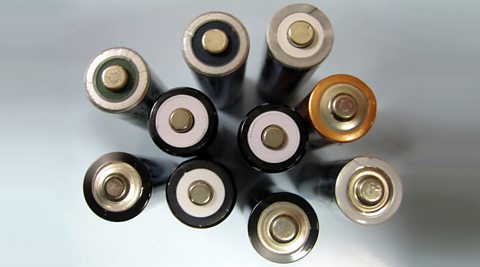Chemical cells
cellA store of internal energy that can be transferred as an electric current in a circuit. use chemical reactions to transfer energy by electricityThe flow of charge through a conductor.. The voltageThe potential difference across a cell, electrical supply or electrical component. It is measured in volts (V). of a cell depends upon a number of factors, including what the electrodeA conductor used to establish electrical contact with a circuit. The electrode attached to the negative terminal of a battery is called a negative electrode, or cathode. The electrode attached to the positive terminal of a battery is the positive electrode, or anode. are made from, and the substance used as the electrolyteA substance which, when molten or in solution, will conduct an electric current..

A simple cell can be made by connecting two different metals in contact with an electrolyte. A number of cells can be connected in series to make a batteryA chemical supply of electrical energy. For example, common battery voltages include 1.5 V and 9 V., which has a higher voltage than a single cell.
In non-rechargeable cells, eg alkaline cells, a voltageThe potential difference across a cell, electrical supply or electrical component. It is measured in volts (V). is produced until one of the reactantA substance that reacts together with another substance to form products during a chemical reaction. is used up. When this happens, we say the battery âgoes flatâ.
In rechargeable cells and batteries, like the one used to power your mobile phone, the chemical reactions can be reversed when an circuitA closed loop through which current moves - from a power source, through a series of components, and back into the power source. is supplied.
What affects the voltage of a cell?
Here is a simple reactivity series:
If we connect different combinations of these metals to make a cell, we find that the voltage changes. In the below table, the positive electrodes and what they are made from are listed along the top and the negative electrodes along the side.
| Magnesium -2.37 | Zinc -0.76 | Copper +0.34 | |
| Magnesium | 0.00 V | +1.61 V | +2.71 |
| Zinc | -1.61 V | 0.00 V | +1.10 V |
| Copper | -2.71 V | -1.10 V | 0.00 V |
| Magnesium | |
|---|---|
| Magnesium -2.37 | 0.00 V |
| Zinc -0.76 | +1.61 V |
| Copper +0.34 | +2.71 |
| Zinc | |
|---|---|
| Magnesium -2.37 | -1.61 V |
| Zinc -0.76 | 0.00 V |
| Copper +0.34 | +1.10 V |
| Copper | |
|---|---|
| Magnesium -2.37 | -2.71 V |
| Zinc -0.76 | -1.10 V |
| Copper +0.34 | 0.00 V |
Swapping the two electrodes means that the recorded voltage becomes negative. The biggest voltage occurs when the difference in the reactivity of the two metals is the largest. A cell made from magnesium and copper has a higher voltage than either of the other two combinations.
Question
Suggest the voltage of a cell made using magnesium and silver
Any value greater than 2.71 V would be an acceptable answer. This is because the difference between the reactivity of magnesium and silver is greater than the difference between magnesium and copper. In fact, the cell would have a voltage of approximately 3.5 V.